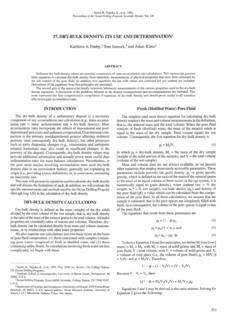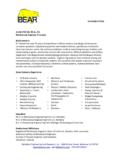Transcription of Technical information on plastics - Radel
1 646* Standard products are subject to the tolerances underDIN 16901. In the case of special materials, the nominaldimensions change in accordance with the oscillationdifference from the special material, as do the tolerancegroups.* Deviations in dimensions and shapes from the standardversions are due to differences in shrinkage and shrink-age behaviour.* Deviations in colour from standard or RAL colour chartsoccur.* In other surface properties, such as- gloss- structures- lines of flow or streaks on dark colours* Stronger ridges may form* Colour additives can affect the material properties(combustibility, UV resistance)* or advice for machining plastic enclosuresMilling, drillingWhen machining plastic enclosures, the tools must only becooled with oil-free air.
2 Drilling coolants and separatorscan cause splitting and tearing. When using separatorscontaining silicone, subsequent imprinting and lacqueringis not possible as the lacquer would not adhere case of doubt please ask us for machining service protects you against these plastic parts are punched, corners can tear or quality of a glued joint depends on the materials to beglued, the size of the glued area, and the adhesive following should be taken into consideration:1) Only glue the same materials 2) Glue as large an area as possible3) Use suitable glues and follow the Technical instructions4) Test the adhesion under conditions of use, such as tem-perature, strain, etc.
3 Before starting series information on plasticsAll the plastic enclosures we supply are made of one stand-ard material (Euromas of two materials). The standard material is chosen during the design, taking into accountthe data available to us on the use and pricing. The injec-tion tools are made to suit the of our customers use the enclosures under quite different conditions from those we have considered in selecting the material. It is therefore frequently necessaryto use a special material or a special colour, to suit willingly meet customers special requirements, if thetechnical means are available.
4 In the case of materials thatwe cannot use for Technical reasons, we propose viablealternatives on the basis of your material colours / material for plastic enclosuresIn principle, all plastic enclosures can be produced in specialcolours to meet customers wishes. However, the followingfactors need to be taken into consideration:1) the colour required can only be approximately achievedfor production ) In choosing the colour, wherever possible only the standard palette published by the raw materials manu-facturer should be used, as this will enable subsequentorders to be as close as possible to the original delivery time and the quantity of the raw materialrequired are ensured within specific ) Our series production has to be interrupted to set up thenecessary mould.
5 The plant has to be thoroughly cleaned of the previous material to ensure that no im-purities enter the special ) The cleaning required before the special colour can beused causes material we make our products in special colours and/orspecial materials, the following deviations from our stand-ard products are possible for material and productionreasons: Technical information on plastics647 Nominal dimension areaover013610152230405370up to1361015223040537090A to1201602002503154005006308001000A of plastics according to DIN 16901 Deviations from the nominal dimensions are unavoidablein the manufacture of plastic are various reasons for these deviations:a) Processing parameters.
6 These depend on- the evenness of the shape- the setting of the machine- the temperature of the tools- the distortion of the tool under tolerances for this norm have been laid down takinginto account these factors and numerous measurements plastics in this norm are divided into tolerance the plastics used by BOPLA for standard enclosures arein row 130, for which the tolerances given below tolerances apply on the basis of the machining shrink-age worked into the tool only for the appropriate enclo-sure with the standard material = Dimensions which are not tool-specific are those formed by the interaction of movable tool parts, thicknesses and floor thicknesses or dimensionswhich are affected by additives or = Tool-specific dimensions are those in the same part ofthe ) The condition of the tool.
7 -manufacturing tolerances for tool dimensions (see DIN 16749)- wear on tools- deviations in the position of movable tool on membrane keypad tolerances:The installation areas for membrane keypads are dimen-sioned in the catalogue illustrations with the toleranceswhich are present during manufacture. These tolerancesare already restricted in comparison with DIN 16901. As the membrane dimensions are also furnished with manufacturing tolerances, this may result in undesirablecrack dimensions (greatest dimension - enclosure, smallestdimension - membrane).
8 In the case of membrane keypadsdeveloped by Bopla, this is reduced to a dimensions in above data are for guidance only. It has been deter-mined using standardized test pieces and can vary withinnormal combustibility classification refers to the material, anddeviations are possible in finished parts if these have a dif-ferent material material properties of plasticsTestSE 1 PC/ABS- FRPA6 Material propertiesUnitrequirementsPSABSPCGFN1 BlendFR(NV12)GF 15UP-GFImpact strength +20 CKJ/m2 ISO 179 60without30 without3649 Impact strength -40 CDIN 53453 40breaking 30 breaking Notched impact str.
9 (Charpy) +20 CKJ/m2 ISO 17971025 Notched impact str. (Charpy) - 40 CDIN 534534410 Max. bending stressN/mm2 ISO 178 64>70110 >100 DIN 53452 Round body pressure stress CISO 335-1 75125125125 125 DIN 0471/2-5 Retention of shape under heat 1)A CISO 7575801251201209070150150 Retention of shape under heat 1)BDIN 53461 85135130130215190210 Thermal conductivityW/mKDIN C 177 Glow hot wire test C ISO 695 650/2850/1960 850/1 with mm DIN 0471/2-1 CombustibilityGrade UL 94 mmISO 62 Water absorption%DIN 53495< D 570 IEC 93 Surface resistivityohmDIN 53482>1013>1014>1015>1015 >1015>1012 >1012 ASTM 257 IEC 93 Special volume resistivityohmDIN 53482>1016>1015>1016>1015 >1015>1015>1012>1013x cmVDE 303 T3 ASTM 257 IEC 243 Dielectric strengthKV/mmDIN 53481 2826 18 VDE 303 T2 ASTM 1491)
10 The ability of the enclosures to maintain their shape when subject to heat depends on a seal being inserted. The temperature resistance can still be affected bymechanical information on plastics649 The resistance of plastics to chemicalsPS ABS PC PC/ABSPA UP-GFblend Polyester Acetic acid50%25%10%10%5%10%Acetone------------ +---Ammonia+25%------10%---Benzene------ o---++Benzole------------+---Brake fluid o------++Butane---++++ Butanol ++Calcium chloride+++ 10%+Carbon disulphide------------+---Caustic potash solution50%50%------50%---Chlorine benzole------------++Citric acid++10%+ +Diesel oil---+o ++Detergents ++ Engine






